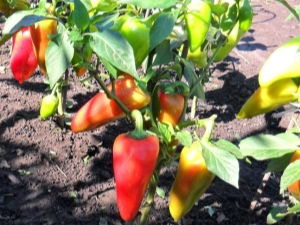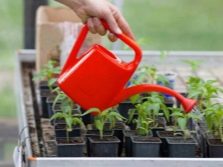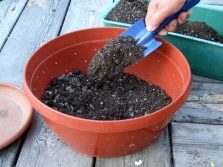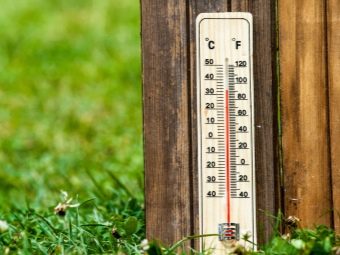Pepper: planting and care in the open field

Pepper is a demanding crop, before the cultivation of which you need to study all the nuances of this process. Proper planting and care in the open field will help to get a rich and healthy harvest of this vegetable.
Basic requirements for growing
Pepper is considered to be a demanding crop, therefore high-quality fruits can be collected only when the necessary growing conditions are met. Experienced gardeners every year enjoy good yields, but beginners face some problems. Even on strong and healthy bushes only a couple of low-quality fruit grows, or the ovaries fall. To get a rich harvest, you should learn the key rules for growing this vegetable.
The process of growing peppers should occur under the following conditions:
- quality material for planting;
- competent selection of the site and soil preparation;
- the correct timing of planting plants in a permanent place;
- providing culture with the necessary care.
When growing, it should be ensured that the seedlings develop at the right temperature, they are provided with a sufficient amount of lighting, moisture and fertilizers.
How to grow seedlings?
Gardeners who do not have a greenhouse, begin to engage in planting seeds in February. Subject to the deadlines in May, seedlings will be about 90-100 days. Pepper has a negative attitude to diving, therefore, the planting of grains should be made in a peat pot, whose diameter is 8-10 cm. Larger containers are irrelevant, so the roots develop slowly. You can also make a landing in a coconut substrate or in the soil with a hydrogel that helps preserve moisture.
Soil mixture under the pepper should have a loose structure. The composition of two parts of humus is welcomed, in which 1 fraction of sand and 1 part of soil is added. For every kilogram of this substrate, you will need one large spoonful of ash.
The soil must be present neutral level of acidity. Otherwise, liming is required. In loam, you can add a little rotted peat and sand. Humus and turf soil are added to the peat soil. For sandy land will need a little sawdust with humus.
For seeds, pre-treatment should be carried out, consisting in soaking in water. Future pepper will be about five hours in the water, the temperature of which is 50 degrees. Then the grains are placed in a moistened cloth for a couple of days. The temperature in the room should reach 20 degrees Celsius. With the help of such activities, the pepper will begin to rise the next day after planting.
It will also require disinfection of the grains. For this purpose, a manganese solution is used, in which future peppers are soaked for 30 minutes. After this, rinsing in tap water is performed. Many agricultural technicians use special growth promoters. Well proved means "Epin."
Sow peppers should be watered and placed on the surface of the container under a film or glass. Until the seedlings appear, it is necessary to ensure a warm temperature. Lighting does not play an important role, so you can leave the future seedlings in the dark. When the seedlings appear on the surface, during the daytime there should be a temperature of 26-28 degrees Celsius. For the night is enough 10-15 degrees.
Excess moisture can cause black leg (a common disease). However, the drying of the soil mixture is unacceptable. Watering seedlings should only be warm water, the temperature of which is 30 degrees. If you use a cold liquid, the seedlings will become weak, start to hurt, which can lead to its death. Experienced gardeners monitor the air condition in the room. We can not allow dryness, for this reason, the seedlings should be sprayed and the room ventilated.
To grow good seedlings, you need to follow a few rules:
- Ensuring a sufficient level of humidity in the room.This is achieved by simple spraying or a special humidifier.
- Periodically, the room should be ventilated. Care should be taken that the seedlings are not affected by the draft. Some gardeners resort to hiding seedlings for the period of airing.
- Auxiliary lighting is created using fitolampy or fluorescent light bulbs.
Seedlings will need an auxiliary light. In February, you need to cover it from 7-21 hours. Before moving the seedlings to the open ground, hardening will be required, carefully accustoming the plants to sunlight, low temperatures and outdoor weather. To this end, the seedlings are placed on the street and carefully increase the period of stay in the new conditions. When hardening, you need to monitor the weather and eliminate the contact of pepper with frost and low temperature conditions.
How and when to land?
Peppers should grow in light soil. Preparations for the site should be made one year before disembarking. It will be necessary to add 5 kg of additives of animal origin under the preceding plants (this dose is calculated per square meter of planting). In the autumn, 50 g of phosphate is added and a deep digging of the territory is made. In the spring season, ammonium nitrate (40 g) is added to the upper soil layers.
Five days before the moment when the seedlings will be planted in open ground, care should be taken to disinfect the ground. The procedure is carried out at the expense of the mixture on the copper sulphate. One bucket of water will require one large spoonful of the substance.
Replace bushes for permanent residence should be in May (end of the month) or in mid-June. When planting must be respected scheme 40x40. In greenhouses without heating, seedlings can be placed in early April. For tunnel shelters should wait until the end of spring.
When planting in the wells, you should try to plant peppers to a depth that is identical with the depth in the seedling container. It is important to plant the plant properly without damaging the roots. You can not leave the root system open, dropping the root neck. Peppers do not like cold soil, so the beds should be raised by 30-60 cm.
Pepper is susceptible to over-pollination, therefore when planting several varieties on the plot, the seedlings should be located at a great distance from each other. If there is an opportunity, tall tomatoes, corn or sunflower should be planted between the bushes of the sweet and other species.
Landing rules
A favorable period for transplanting peppers is cloudy weather conditions. At this point, the young bush will not suffer from exposure to sunlight and will adapt more quickly to the new territory. Disembarkation is carried out in the recesses, the distance between which will be dependent on the variety used. The distance between low-growing crops should be 40 cm, for tall plants - 60 cm, for bitter plants - 25 cm. If 2 pieces are placed at a time, the planting pattern will be 60x60.
With self-growing seedlings before transplanting it to a permanent place, it is necessary to water the soil well. This makes it easier to pull out the earthen clod. Experienced gardeners before diving sprinkle saplings means "Strela", which provides protection from attacks by aphids.
If the soil is endowed with nutrients, it will be enough just to water the hole and place the seedling in it. With a lack of components in the well, you need to add rotted compost, ashes and superphosphates. After that, you can start watering and plant the plant. At the last stage the land is mulched.
How to care?
To pepper gave enviable yields, he will need to provide proper care. It is enclosed in a competent agricultural techniques, which consists of several stages.
Frost protection
Gardeners living in the central part and in the northern regions often wonder what to do if the frosts have suddenly returned.The issue is urgent, because the pepper does not tolerate a cold snap and is able to die. Experienced gardeners study the weather forecast in advance so that frosts are not a surprise for them.
Pepper is a plant that painfully reacts to the return of cold weather. The plant begins to decrease immunity, because of which it is exposed to diseases. If the seedlings were hardened before planting in the open ground, the pepper will be able to more easily cope with the climatic stresses. Fertile soil makes it possible to endure frosts with fewer losses, but additional protection is still required.
The following methods of protection are used:
- sprinkling and irrigation method;
- smoking;
- shelter bushes.
Sprinkling is the appearance of a small thickness of ice on the bush. She will act as a defense. For sprinkling, simply spray the plants with water.
Smoke is considered to be a rather complicated method, which can be used only in calm weather. Using this method is relevant if the temperature has not dropped below -4 degrees. Smoke heaps of 1x1.5 m in size should be located throughout the site. They may consist of firewood and branches (base), straw with leaves (middle) and earth (top layer). Equipped heaps are burned every night until the weather becomes warmer.
Shelter bushes is the construction of special tents. They can be created from any available material: boxes, old clothes, plywood and other debris. Such facilities are cleaned every morning. If the cold weather is protracted, you can use plastic wrap.
Temperature
Temperature should be monitored. Pepper will feel good at 20-25 degrees. If the thermometer drops below 13 degrees, you will need to create a shelter for seedlings. If we ignore this rule, the bushes will begin to reset the ovary.
Watering
To water the bushes of pepper need to settle water, the temperature of which is 24-26 degrees. Until flowering occurs, the soil should be moistened once a week. Liquid consumption is 12 liters per square meter. If there is a strong heat, watering is increased to two times. When flowering and fruiting seedlings need to be watered three times a week. The dosage is increased to 14 liters per square meter.
Loosening
The root system of pepper bushes is too delicate, so plants need periodic loosening. With it, the roots get the necessary amount of air.
Features of loosening.
- The first time it is carried out at a shallow depth (up to 10 cm). It is impossible to loosen the soil earlier than two weeks after transplantation into open ground.
- Further procedures should be performed after each rain and watering to prevent the formation of a hard crust.
- During flowering should soil the soil after each loosening.
Formation
To pepper pleased their owners with large fruits, each bush should be formed. The procedure is to remove excess shoots. All stepchildren, which are located after the first branching, must be removed entirely. They do not carry any benefit and only take nutrients from the plant, interfering with the fruiting process.
Thinning the crown will help each branch get enough air and light. Thickened bushes are not capable of forming many ovaries and are distinguished by small fruits. Trimming is carried out every two weeks. In rainy weather, the procedure will need to be done every 10 days. In parallel, it is necessary to loosen the soil so as not to disturb the seedlings once again.
Pepper has a rather fragile shoots, so inaccurate actions can lead to injury to the bush. To exclude damage, experienced gardeners resorted to the garter of tall plants to support columns.
How to feed?
To feed the pepper should be resorted to before transplanting into open soil.Timely top dressing makes it possible to grow high-quality and strong plants with a large number of large and healthy fruits. Seedlings need to be fed nettle infusion. It is easy to prepare using one particle of nettle and ten parts of water. Formed mixture should be infused for two days.
During the entire vegetative season, the plants will need at least three feedings. The first portion will be required 14 days after planting. For her, you can use liquid mullein or chicken manure.
Flowering bushes should be fed with a mixture of herbs. To do this, you can use the leaves of dandelions, woodlice, coltsfoot, nettles and plantain. All of these herbs are crushed and mixed with a bucket of liquid mullein and 10 large spoons of ash. Then the mixture is diluted in a container of water (100 l) and left for 10 days. For each seedling will need 1 liter of the mixture. Such actions saturate pepper with nutrients and make it more resistant to negative factors.
For intensively growing seedlings will require the following feeding:
- nitrophoska (250 g);
- cow dung (5 l);
- water (100 l).
Such a solution should be infused for 7 days. One bush requires 1.5 liters of nutrient mixture. After a couple of weeks, you can start the second feeding, which consists of 0.5 bucket of chicken manure, a glass of urea, 1 bucket of mullein. Infuse the mixture should be in 100 liters of water throughout the week. Each square meter will require about 5 liters.
The appearance of pepper can tell what substances it lacks:
- if the leaves are white, it indicates a lack of nitrogen;
- twisted leaflets indicate a deficiency of potassium;
- purple hue indicates a phosphorus deficiency.
During the cultivation of pepper should be monitored for its condition and alternate between organic and mineral additives.
Harvesting and storage
During fruit picking, it should be understood that there are two types of maturity:
- technical;
- biological.
If instant use of sweet pepper is planned, the assembly should begin when the peppers have a rich color. This is biological maturity. For storage and transportation need to pluck more green fruit. This phase is called technical.
The rule for sharp varieties is: the redder the sharper. Connoisseurs of spicy dishes harvest after full ripening. Lovers of aroma can pick off fruits during technical maturity.
Tips
Sweet and burning pepper varieties belong to the nightshade. Such cultures are considered to be demanding in relation to the place of cultivation, as well as to the choice of previous plants. Pepper also belongs to the neighborhood critically. To get high-quality fruit, you should familiarize yourself with the advice of experienced people, which say about which vegetables you can grow peppers next to.
The best neighbor for pepper is considered to be a bush-type beans, as well as legumes. Pests attacking peppers are frightened by the smell of legumes, so plants are less likely to undergo various diseases. In this case, the bushes do not show rivalry for useful components and are not inclined to interfere with each other. Nitrogenous fertilizers are used for legumes, which are also necessary for pepper.
It is undesirable to plant pepper near the solanaceous plant varieties. Tomatoes, eggplants, potatoes can not grow on the same bed. Such cultures should be located at different ends of the site. This is due to the fact that the listed vegetables suffer from identical diseases, so there is a great risk of the death of the entire crop.
You can not dispose of sweet peppers together with hot bushes. This is due to the fact that the plants are prone to over-pollination, with the result that the sweet variety will have a bitter taste.
To prevent soil depletion, to avoid attacks of pests and all sorts of diseases, plants should alternate around the site so that they return to their original place no earlier than three years later.
Good peppers grow after cruciferous plants. This suggests that you can combine seedlings with cabbage. You can also carry out planting after pumpkin crops (zucchini and cucumbers), legumes (soybeans, beans), small seeds (dill, carrot).
You should also familiarize yourself with the basic tips from gardeners, through which you can grow a good harvest.
Under the pepper you need to choose a container, the height of which is about 10-12 cm. This is due to the fact that the pepper is planted to a greater depth compared to the tomato.
The choice of variety should be made on the basis of the region in which the planting is planned. If there is a cool or short summer in the climate zone, it is better to pay attention to stunted varieties or hybrids. If you have a good greenhouse, you can choose any variety.
Pepper loves heat, so it should not be left on the windowsill next to the glass. However, he loves the heat, though not prone to stretching, unlike tomatoes. During the opening of the cotyledonary leaf at the point of growth, a development program is laid. If there is not enough light at this moment, then instead of a fork with the first bud, leaves will form, which will lead to a later ovary and the appearance of fruits.
When a couple of leaves appear on the seedlings, it is advisable to resort to spraying every 10 days with the help of the “Spring Cocktail” or the “Healthy Garden”. It will take a couple of particles of money for 1 liter of water. These funds have a positive effect on seedlings and feed them with useful components.
If there is a flowering process, but there are no ovaries on the bushes, it means that the pepper is in uncomfortable conditions. The reason may be a high level of humidity, elevated temperatures, cooling. To restore the process, you should use the tool "Bud" or "Ovary". Processing should occur in the morning.
Choosing a permanent place of residence for pepper, one should give preference to solar sites where there is no wind. If the weather is hot, culture will need a shadow. It will be useful to mulch the soil with the help of rotted straw, which will keep the ground moisture level in the required condition.
Pepper is susceptible to daylight duration. Such a plant begins to bear fruit early, if the light day lasts less than 12 hours. This quality allows you to get a stable and high yield.
For how to plant peppers in open ground, see the video below.






























































